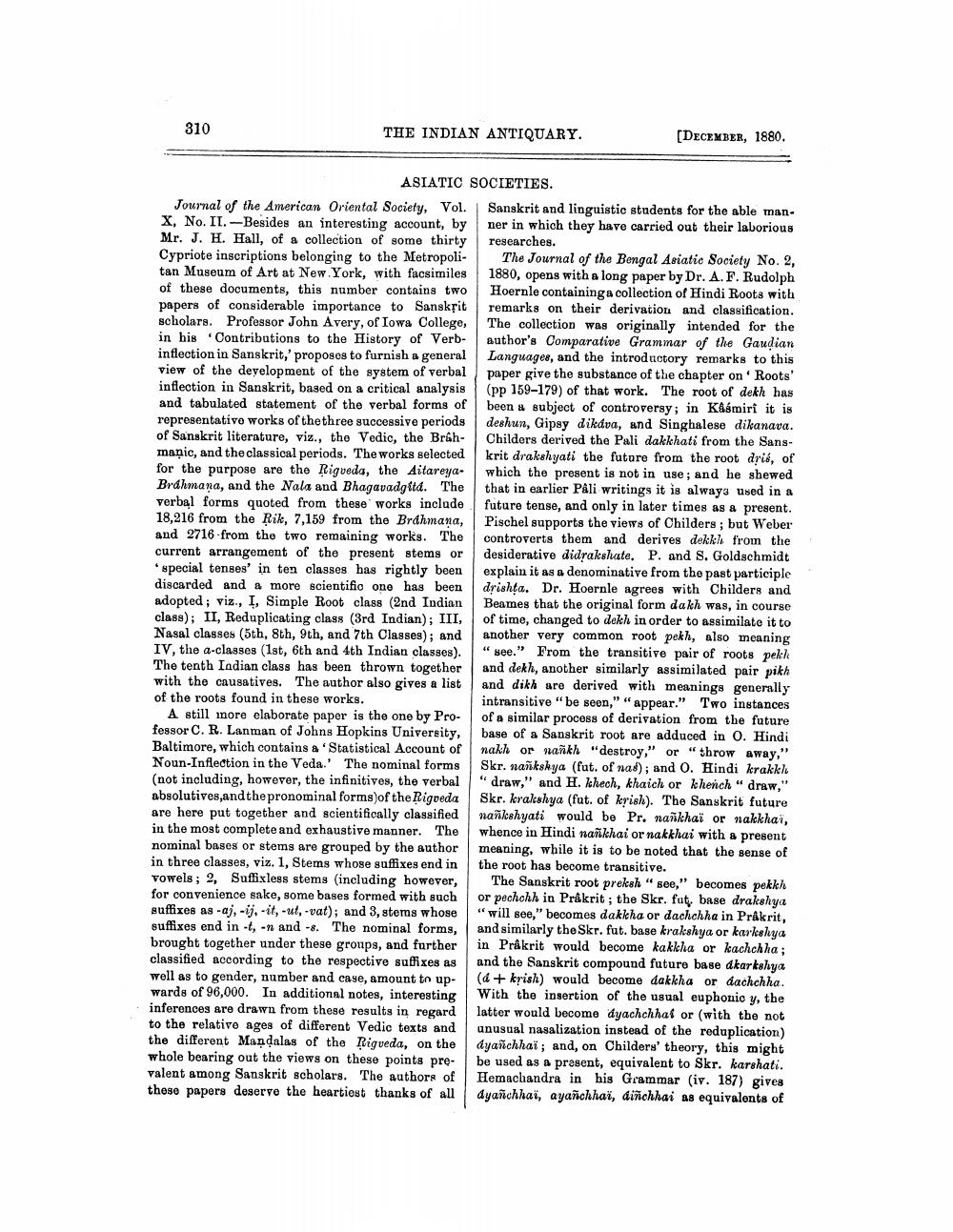________________
310
THE INDIAN ANTIQUARY.
[DECEMBER, 1880.
ASIATIC SOCIETIES. Journal of the American Oriental Society, Vol. Sanskrit and linguistic students for the able man. X, No. II.-Besides an interesting account, by ner in which they have carried out their laborious Mr. J. H. Hall, of a collection of some thirty researches. Cypriote inscriptions belonging to the Metropoli- The Journal of the Bengal Asiatic Society No. 2, tan Museum of Art at New York, with facsimiles 1880, opens with a long paper by Dr. A. F. Rudolph of these documents, this number contains two Hoernle containing a collection of Hindi Roots with papers of considerable importance to Sanskrit remarks on their derivation and classification. scholars. Professor John Avery, of Iowa College, The collection was originally intended for the in his Contributions to the History of Verb- author's Comparative Grammar of the Gaudian inflection in Sanskrit,' proposes to furnish a general Languages, and the introductory remarks to this view of the development of the system of verbal paper give the substance of the chapter on Roots' inflection in Sanskrit, based on a critical analysis (pp 159-179) of that work. The root of dekh has and tabulated statement of the verbal forms of been a subject of controversy; in Kasmiri it is representative works of the three successive periods deshun, Gipsy dikáva, and Singhalese dikanava. of Sanskrit literature, viz., the Vedic, the Brah- Childers derived the Pali dakkhati from the Sansmanic, and the classical periods. The works selected krit drakshyati the future from the root dris, of for the purpose are the Rigveda, the Aitareya- which the present is not in use; and he shewed Brahmana, and the Nala and Bhagavadgita. The that in earlier Pâli writings it is always used in a verbal forms quoted from these works include future tense, and only in later times as a present. 18,216 from the Rik, 7,159 from the Brahmana, Pischel supports the views of Childers; but Weber and 2716 from the two remaining works. The controverts them and derives dekk from the current arrangement of the present stems or desiderative didrakshate. P. and S. Goldschmidt * special tenses' in ten classes has rightly been explain it as a denominative from the past participle discarded and a more scientific one has been drishta. Dr. Hoernle agrees with Childers and adopted; viz., I, Simple Root class (2nd Indian Beames that the original form dakh was, in course class); II, Reduplicating class (3rd Indian); III, of time, changed to dekh in order to assimilate it to Nasal classes (5th, 8th, 9th, and 7th Classes); and another very common root pekh, also meaning IV, the a-classes (1st, 6th and 4th Indian classes). "see." From the transitive pair of roots pekk The tenth Indian class has been thrown together and dekh, another similarly assimilated pair pikh with the causatives. The author also gives a list and dikh are derived with meanings generally of the roots found in these works.
intransitive "be seen," "appear." Two instances A still more elaborate paper is the one by Pro- of a similar process of derivation from the future fessor C. R. Lanman of Johns Hopkins University, base of a Sanskrit root are adduced in 0. Hindi Baltimore, which contains a Statistical Account of nakh or nankh "destroy," or "throw away," Noun-Inflection in the Veda.' The nominal forms Skr. nañkskya (fut. of nas); and 0. Hindi krakkl (not including, however, the infinitives, the verbal "draw," and H. khech, khaich or khench" draw," absolutives and the pronominal forms)of the Rigveda Skr. Kralshya (fut. of krish). The Sanskrit future are here put together and scientifically classified nañkshyati would be Pr. nañkhai or nakkhai, in the most complete and exhaustive manner. The whence in Hindi naskhai or nakkhai with a present nominal bases or stems are grouped by the author meaning, while it is to be noted that the sense of in three classes, viz. 1, Stems whose suffixes end in the root has become transitive. vowels; 2, Suffixless stems (including however, The Sanskrit root preksh "see," becomes pekkh for convenience sake, some bases formed with such or pechohh in Prakrit; the Skr. fut base drakshya suffixes as-aj, -ij, -it, -ut, -vat), and 3, stems whose "will see," becomes dakkha or dachchha in Prakrit, suffixes end in -t, - and -8. The nominal forms, and similarly the Skr. fut. base krakshya or karkshya brought together under these groups, and further in Prakrit would become kakkha or kachchha ; classified according to the respective suffixes as and the Sanskrit compound future base dkarkshya well as to gender, number and case, amount to up- (4 + krish) would become dakkha or dachchha. wards of 96,000. In additional notes, interesting With the insertion of the usual euphonic y, the inferences are drawn from these results in regard latter would become dyachchhai or (with the not to the relative ages of different Vedic texts and unusual nasalization instead of the reduplication) the different Mandalas of the Rigveda, on the dyanchhai; and, on Childers' theory, this might whole bearing out the views on these points pre- be used as a present, equivalent to Skr. karshati. valent among Sanskrit scholars. The authors of Hemachandra in his Grammar (iv. 187) gives these papers deserve the heartiest thanks of all dyanchhai, ayañchhai, dinchhai as equivalents of




